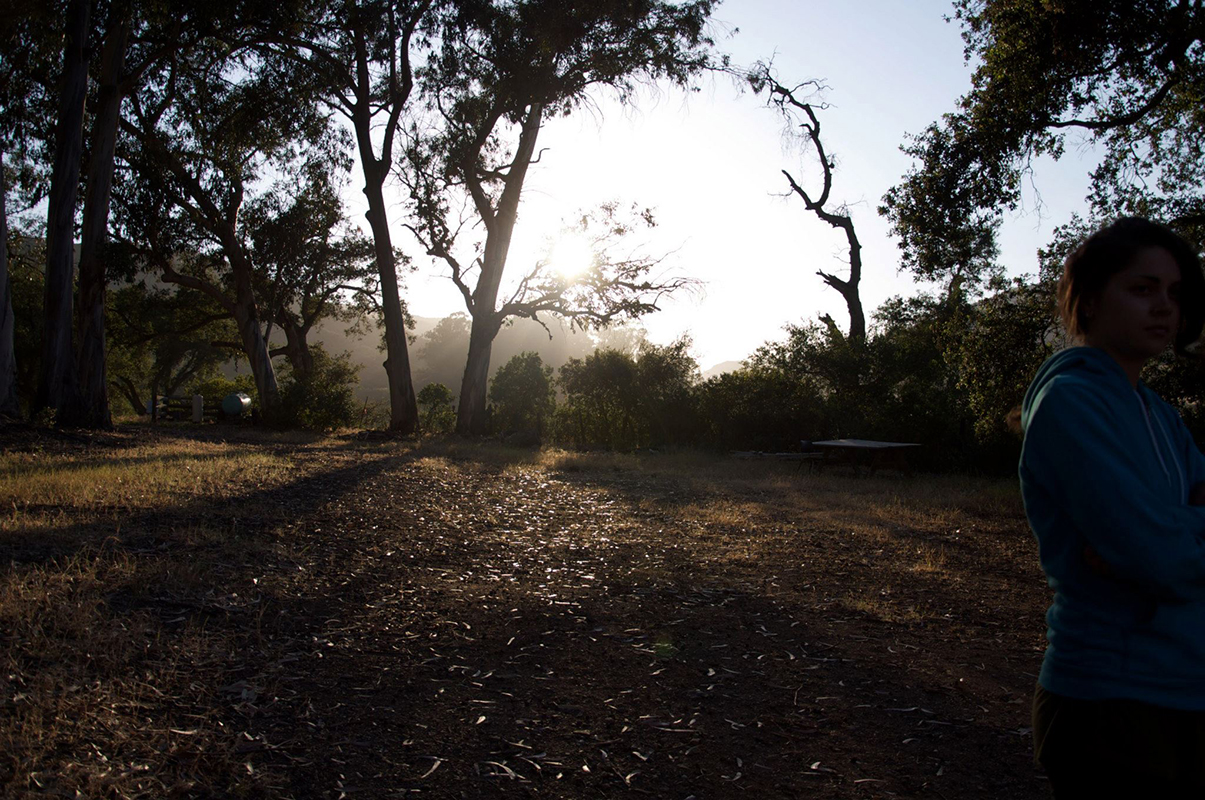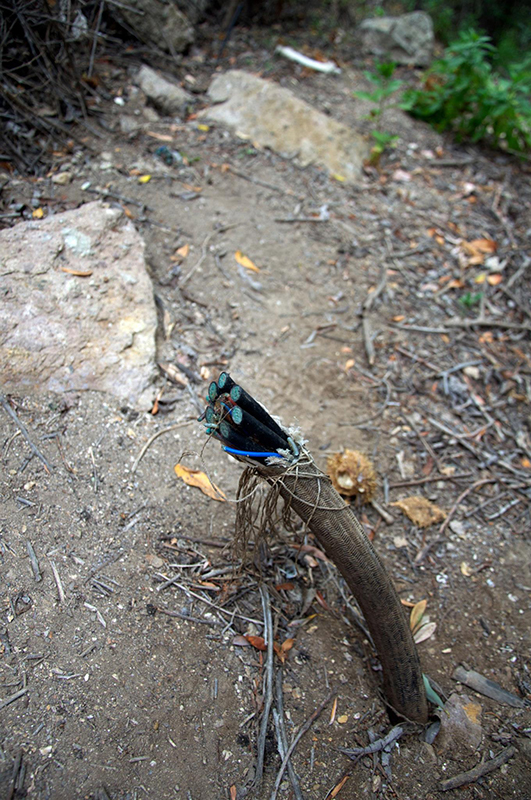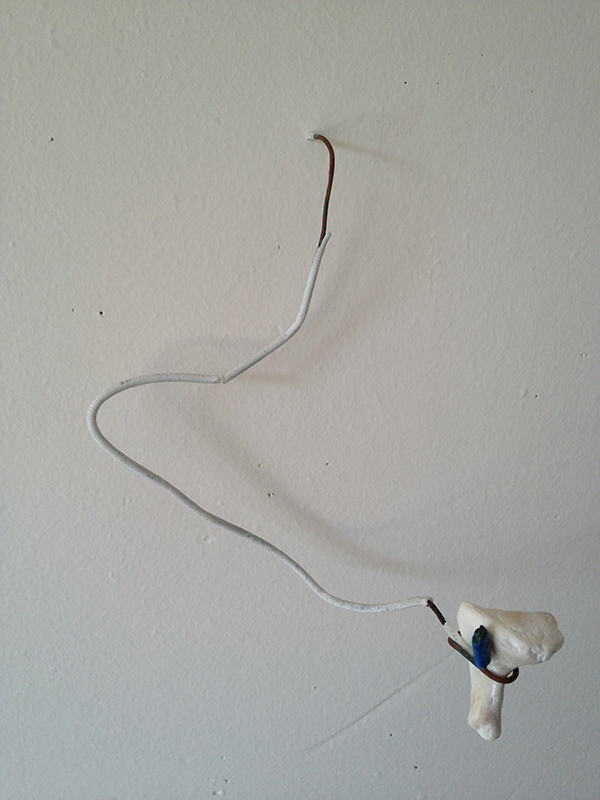Clones and the Elusive Elder Fox
By Raymond Douglas, Anemone(s), Bald Eagle(s), Crab(s), Dragonfly(s), Hermit Crab(s), Island Fox(s), Mice(s), Peregrine Falcon(s), Plant(s), Rock(s), Scrub Jay(s), Sea Lion(s), Spider(s), Star Fish(s), Tree(s) and Unidentified Bird(s)
Started on: 06/01/13 13:32:42
Medium: Conceptual
Started on: 06/01/13 13:32:42
Medium: Conceptual
Disclaimer: This is a perpetual work in progress
The excursion to Santa Cruz Island rests as the most profound of days of this quarter and possibly of this year. I donít know how I could have anticipated anything other than what I experienced during that weekend. The goal of the trip, as a class, was to explore a remote land, document what we were to see, and forge relationships with the unique species that inhabit this isolated environment. What stemmed from these goals, for me, was something quite different and conceptually driven. I still made encounters with wildlife and documented all living and non-living peculiarities of the island, but the island itself, as an idea and as a place of such seemingly wild history, pushed me in a direction that I still canít ignore weeks later.
There are no paved roads. There is no truly permanent human resident on the island. Thereís wifi (more on this later)! The animals are small and quiet but completely new to me. The foxes look like corgis! And Iím obsessed with corgis. Being alone in the islandís wilderness at night is not inherently dangerous for it lacks any large predator. Fears of the night that encompass me on the mainland were quietly left on the shore in Ventura as we departed on the boat. All of these properties of the island allowed me to focus on a geographical location as something more than a product of plate tectonics, something valuable that has tremendous potential to teach and to give guidance. You must, however, leave all doubts and reservations back in modern California.
Sure, animals werenít what triggered this fresh focus of thought. But, the islandís consciousness, as a huge player in natureís arena, absolutely did. If this island trip were to have taken place in any other academic or investigatory context, I canít say if I would be writing this text. A simple Google search will reveal that the island has a long history of human inhabitants. Text on the walls of the UC Field Station in the center of the island says humans have been present for close to 7000 years. This is fascinating, but I was attracted less to the ancient archaeological artifacts of the island and more interested in the man-made artifacts and remnants of the islandís more recent, modern history. Over the course of the weekend I encountered numerous such artifacts that were almost all entirely destroyed by natural processes. (Note: Iím aware that the many structures and vehicles that we encountered are, in fact, not remnants or artifacts but currently used installations by the Nature Conservancy and the University of California.) These objects and locales that I examined and navigated through were, despite their physical and locational differences, part of the same category. They all were evidence of a failed project by someone in the last century. Instead of pursuing facts about these discoveries from the two knowledgeable island caretakers we met, I remained content constructing my own, speculative histories of my findings. But, their common property Ė failure Ė led to a quite intense level of respect for the island and all locations like across the planet. Iíve generated a mythology of my own for why things didnít go as planned for these recent, mysterious projects. What really happened and why is mostly unimportant in the larger conversation of the island as a powerful physical entity that is able to purge all foreign matter from its skin.
My concepts and thought processes are still being reworked and refined weeks after this trip, but one project has already been generated as a result. From two items taken from Valley Anchorage on the south side of the island Iíve started a collection of pairs of artifacts that consist of one natural remnant of a larger system and one man-made remnant. Both, however, have been reduced by the elements of nature to practically the same thing: a failed piece of a larger system. Through all methods of natural erosion, these two originally disparate items have now been given enough similar properties that a metaphysical bond now bridges their original qualitative gap.
Itís worth reiterating that the island as a whole (all insects, animals, marine life, human inhabitants, trees, rocks, climate, and various phenomena) forged this conceptual trail in my mind. If one part of that system were to be missing, the system would fail and erosion would start.
This entire text may not be coherent to everyone. Though I can hope that some of its constituent parts pique the interest of someone, somewhere.
[Write Comment]
The excursion to Santa Cruz Island rests as the most profound of days of this quarter and possibly of this year. I donít know how I could have anticipated anything other than what I experienced during that weekend. The goal of the trip, as a class, was to explore a remote land, document what we were to see, and forge relationships with the unique species that inhabit this isolated environment. What stemmed from these goals, for me, was something quite different and conceptually driven. I still made encounters with wildlife and documented all living and non-living peculiarities of the island, but the island itself, as an idea and as a place of such seemingly wild history, pushed me in a direction that I still canít ignore weeks later.
There are no paved roads. There is no truly permanent human resident on the island. Thereís wifi (more on this later)! The animals are small and quiet but completely new to me. The foxes look like corgis! And Iím obsessed with corgis. Being alone in the islandís wilderness at night is not inherently dangerous for it lacks any large predator. Fears of the night that encompass me on the mainland were quietly left on the shore in Ventura as we departed on the boat. All of these properties of the island allowed me to focus on a geographical location as something more than a product of plate tectonics, something valuable that has tremendous potential to teach and to give guidance. You must, however, leave all doubts and reservations back in modern California.
Sure, animals werenít what triggered this fresh focus of thought. But, the islandís consciousness, as a huge player in natureís arena, absolutely did. If this island trip were to have taken place in any other academic or investigatory context, I canít say if I would be writing this text. A simple Google search will reveal that the island has a long history of human inhabitants. Text on the walls of the UC Field Station in the center of the island says humans have been present for close to 7000 years. This is fascinating, but I was attracted less to the ancient archaeological artifacts of the island and more interested in the man-made artifacts and remnants of the islandís more recent, modern history. Over the course of the weekend I encountered numerous such artifacts that were almost all entirely destroyed by natural processes. (Note: Iím aware that the many structures and vehicles that we encountered are, in fact, not remnants or artifacts but currently used installations by the Nature Conservancy and the University of California.) These objects and locales that I examined and navigated through were, despite their physical and locational differences, part of the same category. They all were evidence of a failed project by someone in the last century. Instead of pursuing facts about these discoveries from the two knowledgeable island caretakers we met, I remained content constructing my own, speculative histories of my findings. But, their common property Ė failure Ė led to a quite intense level of respect for the island and all locations like across the planet. Iíve generated a mythology of my own for why things didnít go as planned for these recent, mysterious projects. What really happened and why is mostly unimportant in the larger conversation of the island as a powerful physical entity that is able to purge all foreign matter from its skin.
My concepts and thought processes are still being reworked and refined weeks after this trip, but one project has already been generated as a result. From two items taken from Valley Anchorage on the south side of the island Iíve started a collection of pairs of artifacts that consist of one natural remnant of a larger system and one man-made remnant. Both, however, have been reduced by the elements of nature to practically the same thing: a failed piece of a larger system. Through all methods of natural erosion, these two originally disparate items have now been given enough similar properties that a metaphysical bond now bridges their original qualitative gap.
Itís worth reiterating that the island as a whole (all insects, animals, marine life, human inhabitants, trees, rocks, climate, and various phenomena) forged this conceptual trail in my mind. If one part of that system were to be missing, the system would fail and erosion would start.
This entire text may not be coherent to everyone. Though I can hope that some of its constituent parts pique the interest of someone, somewhere.

UC Field Station |

UC Field Station Specimens |

Valley Anchorage |

Speculative Modern Artifact #1 |
[Write Comment]